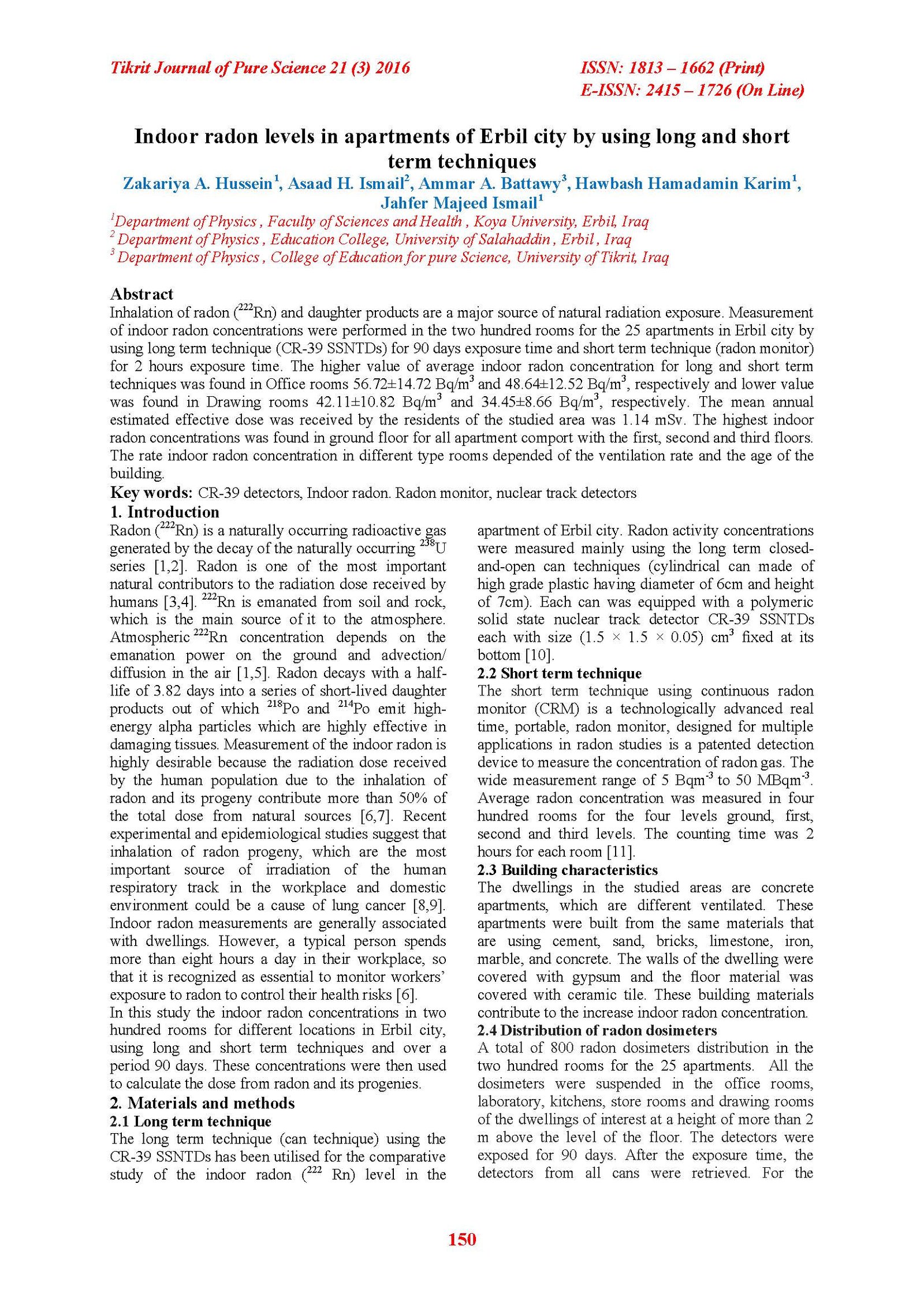Indoor radon levels in apartments of Erbil city by using long and short term techniques
Main Article Content
Abstract
Inhalation of radon (222Rn) and daughter products are a major source of natural radiation exposure. Measurement of indoor radon concentrations were performed in the two hundred rooms for the 25 apartments in Erbil city by using long term technique (CR-39 SSNTDs) for 90 days exposure time and short term technique (radon monitor) for 2 hours exposure time. The higher value of average indoor radon concentration for long and short term techniques was found in Office rooms 56.72±14.72 Bq/m3 and 48.64±12.52 Bq/m3, respectively and lower value was found in Drawing rooms 42.11±10.82 Bq/m3 and 34.45±8.66 Bq/m3, respectively. The mean annual estimated effective dose was received by the residents of the studied area was 1.14 mSv. The highest indoor radon concentrations was found in ground floor for all apartment comport with the first, second and third floors. The rate indoor radon concentration in different type rooms depended of the ventilation rate and the age of the building.
Article Details

This work is licensed under a Creative Commons Attribution 4.0 International License.
Tikrit Journal of Pure Science is licensed under the Creative Commons Attribution 4.0 International License, which allows users to copy, create extracts, abstracts, and new works from the article, alter and revise the article, and make commercial use of the article (including reuse and/or resale of the article by commercial entities), provided the user gives appropriate credit (with a link to the formal publication through the relevant DOI), provides a link to the license, indicates if changes were made, and the licensor is not represented as endorsing the use made of the work. The authors hold the copyright for their published work on the Tikrit J. Pure Sci. website, while Tikrit J. Pure Sci. is responsible for appreciate citation of their work, which is released under CC-BY-4.0, enabling the unrestricted use, distribution, and reproduction of an article in any medium, provided that the original work is properly cited.
References
[1] Espinosa, G., Golzarri, J. and Chavarria, A. (2013). A study of indoor radon in greenhouses in Mexico City, Mexico. Journal of Radioanalytical and Nuclear Chemistry. Volume 296, Pages 37-41.
[2] Al-Khateeb, H. M., Al-Qudah, A. A., Alzoubi, F. Y., Alqadi, M. K. and Aljarrah, K. M. (2012). Radon concentration and radon effective dose rate in dwellings of some villages. Applied Radiation and Isotopes 70 , 1579-1582.
[3] ICRP (International Commission on Radiological Protection). (2000), Lung cancer risk from indoor exposure to radon daughters, Publication 66. [4] Friend and Gooding, 2002 Variations in the concentration of radon in parts of the Ogof Ffynnon Ddu system, Penwyllt, South Wales and estimates of doses to recreational cavers. J. Environ Radioact, 58 (2002), pp. 45–58.
[5] International Commission on Radiological Protection ICRP, (1984). Non-stochastic Effects of Irradiation. ICRP Publication 41. Ann. ICRP. 14.
[6] UNSCEAR. (2000). Sources and effects of ionizing radiation. ANNEX A. Dose assessment methodologies. Report I p.18-82.
[7] EPA (Environmental Protection Agency). (2010). Consumer’s guide to radon reduction; How to fix your home. EPA. 402/K-10/005.
[8] Kavasi, N., Somlai, J., Vigh, T., Tokonami, S., Ishikawa, T., Sorimachi, A. and Kova, C. S. (2009). Difficulties in the dose estimate of workers originated from radon and radon progeny in manganese mine. Radiation Measurements, 44, 300-305.
[9] Khan, M. S., Naqvi, A. H., Azam, A. and Srivastava, D. S. (2011). Radium and radon exhalation studies of soil, Iran. J. Radiat. Res., 8, (4), 207-210. [10] Ismail A H and Jaafar M S.(2010). Relationship between radon concentration, ventilation rate and male infertility: A Case study in Iraqi Kurdistan. International Journal of Low Radiation 7(3) p.175-187.
[11] Shapiro, J. 2002. Radiation Protection, A Guide for Scientists, Regulators and Physician. 4thEdition. Harvard University Press: Cambridge, p219 and 444.
[12] Mansour H. H., Khdar S. per, Abdulla H. Y., Muhamad N. Q., Othman M. M. and Qader S., (2005), Measurement of indoor radon levels in Erbil capital by using solid state nuclear track detector, Radiation Measurement, 40, 544-547.
[13] Amin, R. M., Mansy, M., Eissa, M. F., Eissa, H. M. and Shahin, F. M. (2008). Assessment of natural radioactivity and radon exhalation rate in Sannur cave, eastern desert of Egypt. J. Radiol. Prot. 28, 213–222.
[14] Khan, A. J. (2000). A study of indoor radon levels in Indian dwellings, influencing factors and lung cancer risks. Radiation Measurements, 32, 87–92.
[15] IAEA (International Atomic Energy Agency). (1997). Sources and Measurements of Radon and Radon Progeny Applied to Climate and Air Quality Studies: A survey, TECDOC-934.
[16] Rahmana, S.U., Matiullah, B.F., Nasir, T. and Anwar, J. (2011). Monitoring of indoor radon levels around an oil refinery using CR-39 based radon detectors. Islamabad, Pakistan. Original Paper. Indoor and Built Environment, 1-6.
[17] Obed, R.I., Ademola, A.K. and Ogundare, F.O. (2011). Radon measurements by nuclear track detectors in dwelling Oke-Ogun area, South- Western, Nigeria. Radiation Protection Dosimetry, 1–7.
[18] Nsiah - Akoto, I., Fletcher, J.J., Oppon, O.C., Andam, A.B. (2011). Indoor radon levels and the associated effective dose rate determination at Dome in the Great.
[19] Yong-Jin, J., Young, H. R., Kyung, R. D., Jae, H. C., Hae, K. L. and Woon, K. C. (2012). Study on measurement and quantitative analysis of Radon-222 emitted from construction materials. Annals of Nuclear Energy, 49(4), 88-95.
